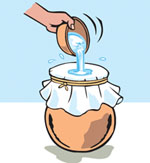Cloth filtration

Cloth filtration. (Source: International Federation of Red Cross and Red Crescent Societies, 2008, Household water treatment and safe storage in emergencies)
Cloth filtration is a common water treatment technique that is easy to use and inexpensive. Cloth filtration can be very effective against cholera, guinea worm (dracunculiasis) and other disease-causing agents. By following the procedures and practice yourself, you can demonstrate this for communities you are working with. The steps in cloth filtration are:
- Use a large cloth, preferably made of finely-woven cotton. The cloth must be big enough to easily cover the opening of the container once it has been folded.
- Fold the cloth at least four times so there are multiple layers of fabric and place this over the opening of the storage vessel.
- Fasten the cloth securely around the rim of the opening and tighten the string. If reusing the cloth, always use the same side up each time.
- Filter all water immediately at source as it is being collected.
- Always keep filtered water separated from non-filtered water.
- Rinse the filter cloth after each use, with a final rinse using cloth-filtered water, and then leave the cloth in the sun until it is dry.
- Clean the cloth regularly using soap and replace it as soon as there are any visible tears or holes.
Last modified: Wednesday, 2 July 2014, 6:20 PM